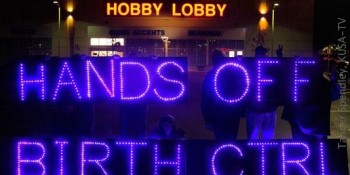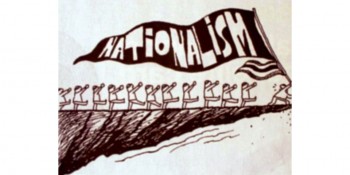Remember, remember, the Fifth of November.
It is fitting that American elections are held during the first week of November — the one time a year when we hear the name Guy Fawkes as we chat briefly about overthrowing governments and installing anarchy. We salivate over how great V for Vendetta is, and how we’d like to head our own utopian government. But, ironically, very few people actually know what happened on the Fifth of November that we’ve come to commemorate.
Sure, some are aware that November 5, 1605, was the day Fawkes tried to bomb the English Parliament, but far fewer know why — or, really, anything else about the man whose face has become a symbol for activists and anarchists everywhere. So, who was Fawkes? What is it he fought for? What is it we are really celebrating? How did he become the symbol we know today? And what are the differences between Fawkes and the fictional character V?
At the turn of the 17th century, Europe was tearing itself apart. Increased literacy and education led to the questioning of traditional religion and its role in state politics. Protestantism was on the rise, and the rift in Christianity left many countries with factions feuding over religious dominance. Henry VIII of England wanted to marry his love, Anne Boleyn, but the Pope refused to annul the king’s wedding to Catherine of Aragon. To get around that complication, the king split from the Pope, who had once called Henry the “defender of the faith,” and the Roman Catholic Church entirely, declaring himself the head of an independent English (or Anglican) Church.
In the coming decades, each subsequent English monarch changed the official religion in some way, including reestablishing the supremacy of Rome for a time. In this environment of constantly shifting religious alliances, it was inevitable that many would take sides and fight for their version of the Christian faith. Under James I, Catholics had hoped to see a move toward greater Catholic religious tolerance. They were disappointed. Anglicanism continued to reign, and the Bible was translated into an authorized English version that bears the king’s name. But some English Catholics were no longer content to wait for the afterlife to see the Protestant leaders judged. And in 1605, one group of conspirators planned to retake the throne for Rome.
The Gunpowder Plot was the attempt by English Catholic subversives to bomb the House of Lords, theoretically leading to the death of King James and the installation of his young daughter, Elizabeth, as a Catholic queen. Fawkes, who many imagine as an anarchist, was in fact among the conspirators hoping to establish a Catholic theocracy. Fawkes was put in charge of guarding the explosives, but he was captured, causing the coup to fizzle out before getting anywhere.
Fawkes was tortured, under the king’s orders, to compel the man to give up the names of his co-conspirators. While his resolve remained strong at first, the increasing brutality of the torture eventually broke Fawkes. To understand the full scale of the beating Fawkes received, one must only look at his signature before and after his torture. Fawkes and his cohorts were tried and sentenced to death, with the added humiliation of being hanged, drawn, and quartered. Fawkes, defiant to the end, evaded part of the punishment when he jumped and broke his neck, avoiding having his guts and testicles cut apart while still conscious.
Not long after the failure of the Gunpowder Plot, November 5 was declared a day of thanksgiving to celebrate the king’s survival. The holiday acquired the name of Bonfire Day because crowds would burn effigies of Fawkes and the Pope. Unsurprisingly, this worsened the bad blood between the Christian sects.
Guy Fawkes/Bonfire Day has evolved over the centuries and taken on new meaning as public opinions and sympathies have changed. For the first several centuries, the holiday was very obviously a celebration of the plot’s failure. When the monarchy did temporarily fall midcentury, the focus ceased to be on the survival of the king, but on the supremacy of Protestantism and parliamentary rule. Today, it is harder to pin down whether folks are celebrating the survival of English government or the idea of destroying it.
Either way, Fawkes became a symbol, with his name and likeness surviving long after his execution. In fact, the word “guy” is derived from the effigies of Guy Fawkes. The effigies were often made by children out of old clothing and called “guys.” The term became a pejorative for poorly dressed men, though it evolved in time to mean any male, losing its negative connotation.
Over two centuries after the failed plot, in 1841, William Harrison Ainsworth’s historical romance Guy Fawkes; or, The Gunpowder Treason was released, portraying Fawkes as a more sympathetic character. Fawkes continued to appear in new works over the next century, but none would do as much for the man’s image as Alan Moore and David Lloyd’s graphic novel of the 1980s, V for Vendetta.
V for Vendetta was Moore’s first attempt at writing a continuing, serialized story. The story, as written in the comic, is set in the dystopian future of 1997. English fascists have overtaken the country following a devastating nuclear war. The state suppresses dissent, eliminates the ethnically diverse, and broadcasts the government’s message everyday. Essentially, the government is a cross between that portrayed in George Orwell’s 1984 and Adolf Hitler’s Germany.
The party in power, Norsefire, meets its match in the anarchist vigilante, V, who dons a cloak and Fawkes mask as he takes to the streets, killing men and women who performed great evil on him or mankind. Unlike traditional heroes, V is not squeamish about killing; rather, death is all he seeks for his adversaries.
V is an ambiguous character with a shrouded backstory and even more mysterious morality. The vigilante is a victim of fascist concentration camps and experimentation. The experiments appear to have had an effect on his mind, possibly driving him mad, though he sees his mission with absolute clarity of purpose. V seems content with becoming a monster himself in order to combat the monsters of Norsefire. V strikes terror into the hearts of the fascists in order to inspire the masses and find vengeance.
While the true story of the Fifth of November can be seen as a dispute between Protestants and Catholics, or between conventional authority and subversive terrorism, V for Vendetta is about a battle between fascism and anarchy — two words with less than favorable reputations. Moore, an anarchist himself, crafts his hero around these principles and even takes time to dispel certain ideas of anarchism. In the novel, V explains that chaos is not the anarchist system; rather, a functional anarchist system would grant great freedom, not the looting and destruction that follows the immediate fall of government.
Moore also does much to make the reader question V’s methods. Moore and Lloyd raise some of the same difficult questions through V as the actions of the Gunpowder Plot raise, such as: When is violence — even murder — acceptable?
In the 2006 film adaptation of the graphic novel, the Wachowskis clung to the principle that killing in the name of freedom is acceptable — and, according to Moore, kept little else from the source material.
In an interview with MTV, Moore explained his problems with the film adaptation.
“It’s been turned into a Bush-era parable by people too timid to set a political satire in their own country,” Moore said. “In the film, you’ve got a sinister group of right-wing figures — not fascists, but you know that they’re bad guys — and what they have done is manufactured a bio-terror weapon in secret, so that they can fake a massive terrorist incident to get everybody on their side, so that they can pursue their right-wing agenda. It’s a thwarted and frustrated and perhaps largely impotent American liberal fantasy of someone with American liberal values [standing up] against a state run by neo-conservatives — which is not what V for Vendetta was about. It was about fascism, it was about anarchy, it was about [England].”
Moore’s criticism of the movie is accurate, but a bit close-minded. While the graphic novel was about 80s-era Thatcherism, the film was intentionally made to evoke images of the modern world. And, in fact, the film’s message had a greater impact than the original creators could have ever hoped. It made their hero and his signature mask into an icon of defiance. The visage of Fawkes, long burned in effigy with feelings of malice, has been adopted by groups such as Anonymous and the Occupy Movement as a symbol of their fight against oppression.
As Moore explained in an interview with The Guardian, “Suppose when I was writing V for Vendetta, I would in my secret heart of hearts, have thought: wouldn’t it be great if these ideas actually made an impact? So when you start to see that idle fantasy intrude on the regular world … It’s peculiar. It feels like a character I created 30 years ago has somehow escaped the realm of fiction.”
But if you are going to don a Guy Fawkes mask to make your political point, it is important to remember the differences between Fawkes and V.
Fawkes was fighting for Catholicism, not anarchy. It could be argued that the Gunpowder Plot was about religious liberty, but it could just as easily be said that Fawkes and the conspirators were looking to establish a different — but still oppressive — theocracy. Still, Fawkes works well as a symbol in opposition to the status quo.
Fawkes was not a sole man on a mission, but rather part of a team — and not even its leader. V, on the other hand, is as alone as a crusader can be. V actively tries to become the symbol that Fawkes became and chooses to use his legacy to change the minds of the world.
It is unlikely that Fawkes ever saw himself as any type of progressive, such as V. Rather, he was a reactionary, fighting for things to return to the way they were a century prior. Still, his act of defiance, which had been derided for centuries, has become an inspiration to all of those looking to fight against the machine. His spirit lives on in the progressive aspirations of the antihero of V for Vendetta, as the film advocates for racial equity, gender equality, religious tolerance, and even sexual orientation and transgender rights.










